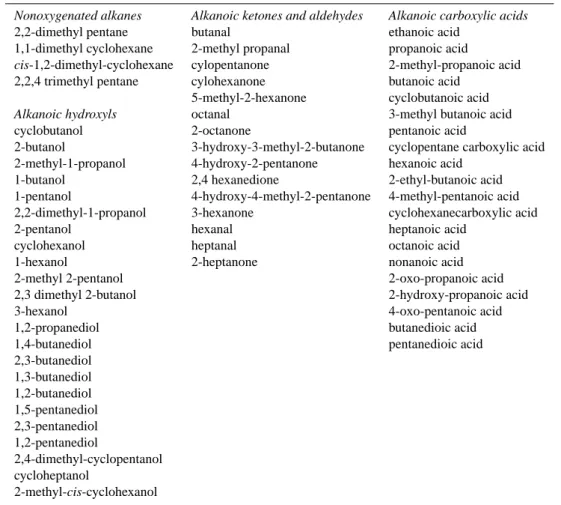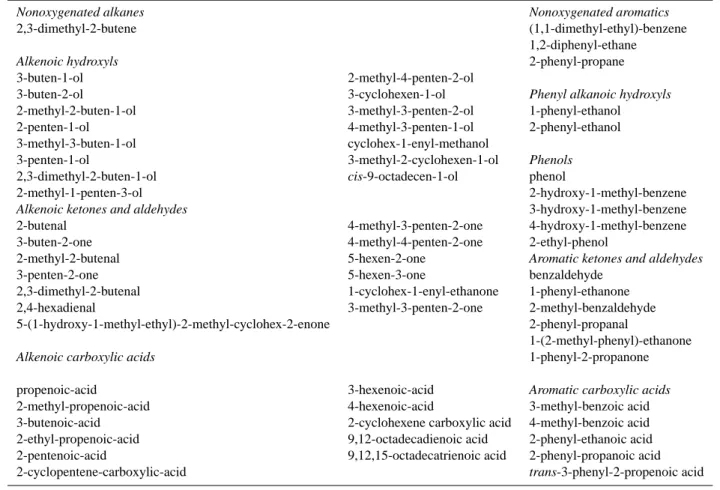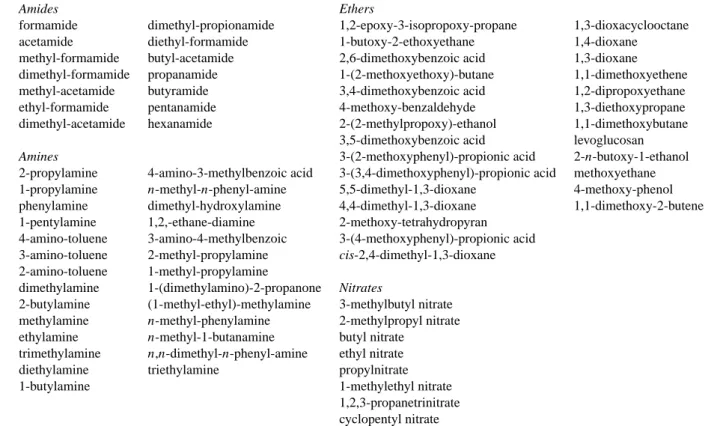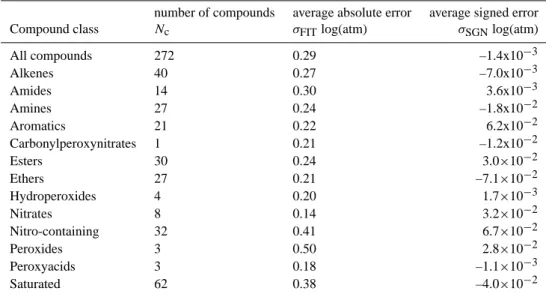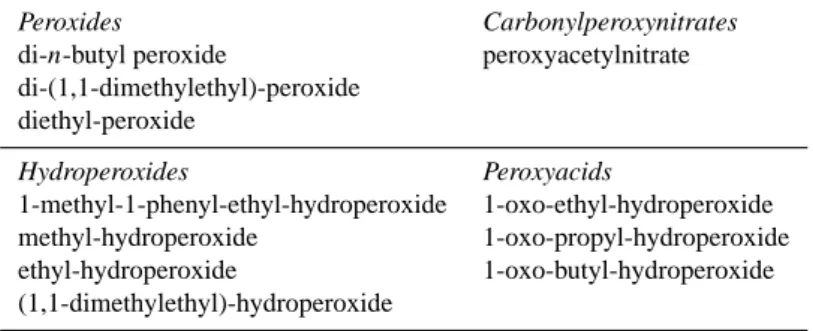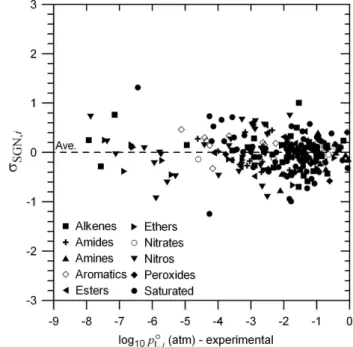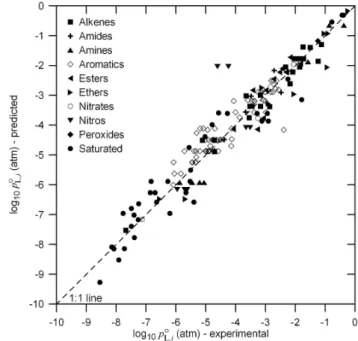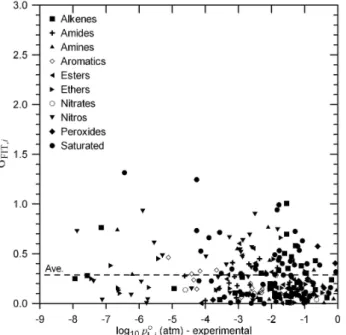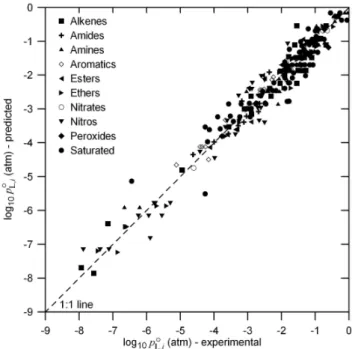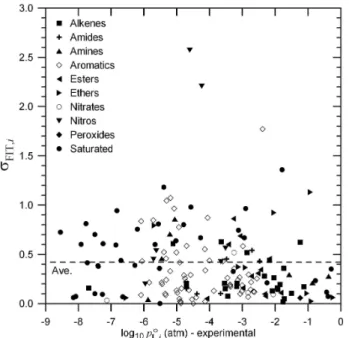HAL Id: hal-00296558
https://hal.archives-ouvertes.fr/hal-00296558
Submitted on 29 May 2008
HAL
is a multi-disciplinary open access archive for the deposit and dissemination of sci- entific research documents, whether they are pub- lished or not. The documents may come from teaching and research institutions in France or abroad, or from public or private research centers.
L’archive ouverte pluridisciplinaire
HAL, estdestinée au dépôt et à la diffusion de documents scientifiques de niveau recherche, publiés ou non, émanant des établissements d’enseignement et de recherche français ou étrangers, des laboratoires publics ou privés.
predicting vapor pressures and enthalpies of vaporization of multifunctional organic compounds
J. F. Pankow, W. E. Asher
To cite this version:
J. F. Pankow, W. E. Asher. SIMPOL.1: a simple group contribution method for predicting vapor pres-
sures and enthalpies of vaporization of multifunctional organic compounds. Atmospheric Chemistry
and Physics, European Geosciences Union, 2008, 8 (10), pp.2773-2796. �hal-00296558�
© Author(s) 2008. This work is distributed under the Creative Commons Attribution 3.0 License.
Chemistry and Physics
SIMPOL.1: a simple group contribution method for predicting vapor pressures and enthalpies of vaporization of multifunctional organic compounds
J. F. Pankow1and W. E. Asher1,2
1Department of Environmental and Biomolecular Systems, OGI School of Science and Engineering, Oregon Health and Science University, Beaverton, Oregon 97006-8921, USA
2Air-Sea Interaction and Remote Sensing Department, Applied Physics Laboratory, University of Washington, Seattle, Washington 98105, USA
Received: 3 July 2007 – Published in Atmos. Chem. Phys. Discuss.: 13 August 2007 Revised: 17 April 2008 – Accepted: 5 May 2008 – Published: 29 May 2008
Abstract. The SIMPOL.1 group contribution method is de- veloped for predicting the liquid vapor pressure poL (atm) and enthalpy of vaporization1Hvap (kJ mol−1)of organic compounds as functions of temperature (T ). For each com- pound i, the method assumes log10poL,i(T )=P
kνk,ibk(T ) whereνk,i is the number of groups of type k, and bk(T ) is the contribution to log10poL,i(T ) by each group of type k. A zeroeth group is included that usesb0(T )withν0,i=1 for all i. A total of 30 structural groups are considered:
molecular carbon, alkyl hydroxyl, aromatic hydroxyl, alkyl ether, alkyl ring ether, aromatic ether, aldehyde, ketone, carboxylic acid, ester, nitrate, nitro, alkyl amine (primary, secondary, and tertiary), aromatic amine, amide (primary, secondary, and tertiary), peroxide, hydroperoxide, peroxy acid, C=C, carbonylperoxynitrate, nitro-phenol, nitro-ester, aromatic rings, non-aromatic rings, C=C–C=O in a non- aromatic ring, and carbon on the acid-side of an amide. The T dependence in each of the bk(T ) is assumed to follow b(T )=B1/T+B2+B3T+B4lnT. Values of the B coeffi- cients are fit using an initial basis set of 272 compounds for which experimentally based functionspoL,i=fi(T )are avail- able. The range of vapor pressure considered spans fourteen orders of magnitude. The ability of the initially fittedBco- efficients to predictpoL values is examined using a test set of 184 compounds and aT range that is as wide as 273.15 to 393.15 K for some compounds.σFITis defined as the average over all points of the absolute value of the difference between
Correspondence to: J. F Pankow (pankow@ebs.ogi.edu)
experimental and predicted values of log10pL,io (T ). After consideration ofσFITfor the test set, the initial basis set and test set compounds are combined, and theBcoefficients re- optimized. For all compounds and temperatures,σFIT=0.34:
on average,poL,i(T )values are predicted to within a factor of 2. Becaused(log10pL,io (T ))/d(1/T )is related to the enthalpy of vaporization1Hvap,i, the fittedB provide predictions of 1Hvap,ibased on structure.
1 Introduction
For organic compoundi, knowledge of the liquid vapor pres- surepL, io at the system temperature (T ) is required when- ever phase equilibrium ofibetween a liquid phase and the gas phase is of interest. This type of partitioning arises fre- quently in many disciplines, and so the need for reliablepoL, i values is considerable. And, since theT dependence ofpoL, i is determined by the compound-dependent enthalpy of va- porization1Hvap,i, the same need extends to 1Hvap,i val- ues. In our case, the topic of interest is gas/particle partition- ing in atmospheric and smoke aerosol systems (e.g., Pankow, 1994a, 1994b, 2001, 2003; Pankow et al., 2001, 2003, 2004;
Barsanti and Pankow, 2004, 2005, 2006).
Given the infinite structural variety possible with organic compounds, laboratory measurements will never keep pace with the need for newpoL, iinformation. Consequently, there is continuing interest in the development of reliable meth- ods for predicting pL, io and 1Hvap,i values. In the case of the behavior and formation of organic particulate mat- ter (OPM) in the atmosphere, there is growing interest in a
Table 1a. Non-oxygenated, hydroxyl, ketones, aldehydes, and carboxylic acid saturated compounds in the basis set for the initial fit.
Nonoxygenated alkanes Alkanoic ketones and aldehydes Alkanoic carboxylic acids
2,2-dimethyl pentane butanal ethanoic acid
1,1-dimethyl cyclohexane 2-methyl propanal propanoic acid
cis-1,2-dimethyl-cyclohexane cylopentanone 2-methyl-propanoic acid
2,2,4 trimethyl pentane cylohexanone butanoic acid
5-methyl-2-hexanone cyclobutanoic acid
Alkanoic hydroxyls octanal 3-methyl butanoic acid
cyclobutanol 2-octanone pentanoic acid
2-butanol 3-hydroxy-3-methyl-2-butanone cyclopentane carboxylic acid 2-methyl-1-propanol 4-hydroxy-2-pentanone hexanoic acid
1-butanol 2,4 hexanedione 2-ethyl-butanoic acid
1-pentanol 4-hydroxy-4-methyl-2-pentanone 4-methyl-pentanoic acid 2,2-dimethyl-1-propanol 3-hexanone cyclohexanecarboxylic acid
2-pentanol hexanal heptanoic acid
cyclohexanol heptanal octanoic acid
1-hexanol 2-heptanone nonanoic acid
2-methyl 2-pentanol 2-oxo-propanoic acid
2,3 dimethyl 2-butanol 2-hydroxy-propanoic acid
3-hexanol 4-oxo-pentanoic acid
1,2-propanediol butanedioic acid
1,4-butanediol pentanedioic acid
2,3-butanediol 1,3-butanediol 1,2-butanediol 1,5-pentanediol 2,3-pentanediol 1,2-pentanediol
2,4-dimethyl-cyclopentanol cycloheptanol
2-methyl-cis-cyclohexanol
wide range of multi-functional oxygenated compounds and nitrogen-containing compounds, e.g., hydroxy acids, diacids, hydroxy diacids, hydroxy aldehydes, organic nitrates, nitro aldehydes, etc.
Quantum-mechanical calculations are making steady progress in the theater of predictingpL, io values for any struc- ture of interest (Diedenhofen et al., 2007; Verevkin et al., 2007; Banerjee et al., 2006; Tong et al., 2004). However, prediction efforts for more complicated structures can now only be based on either a complex consideration of the inter- action forces between molecules (i.e., dispersion, induction, dipole and H-bonding) as in the SPARC model discussed by Hilal et al. (1994), or by empirical group-contribution means.
In the group contribution approach to prediction of molec- ular properties, it is hypothesized that the value of a property of interest for compoundi can be predicted based on em- pirically determinable contributions from the structural frag- ments that comprisei. As a function of temperatureT, the result is often an equation of the type
log10Zi(T )=b0(T ) + X
kνk,ibk(T ) (1)
where: Zi(T )is the property of interest, e.g., poL, i(T ); the parameterb0(T )is aT-dependent constant;νk,iis the num- ber of groups of typek ini; the index k may take on the values 1,2,3, etc.; andbk(T )is the group contribution term for groupk. Values forb0(T )and the set ofbk(T )are usu- ally determined by fitting (i.e., optimizing) Eq. (1) using laboratory-based measures of Zi(T ) for a large number of compounds that contain the groups of interest. For exam- ple, for both 2,3- and 2,4-dihydroxypentane it can be con- sidered thatνOH, i= 2, νCH3, i=2,νCH2,i=1, andνCH,i=2. In this approach, fourbk(T ) values are required, and Eq. (1) will give the same prediction for Zi(T ) for both isomers.
However, the vicinal nature of the two OH groups in 2,3- dihydroxypentane allows greater intramolecular interaction of the OH groups (and less intermolecular interaction) than in the 2,4 isomer, causing differences in molecular proper- ties. In the case of vapor pressure,poL, i(T )will be higher for the 2,3 isomer than for the 2,4 isomer. Accounting for such property differences among isomers can be ac- complished by consideration of additional, “higher-order”
groups. Thus, for 2,3-dihydroxypentane a “second-order”
Table 1b. Continued.
Nonoxygenated alkanes Nonoxygenated aromatics
2,3-dimethyl-2-butene (1,1-dimethyl-ethyl)-benzene
1,2-diphenyl-ethane
Alkenoic hydroxyls 2-phenyl-propane
3-buten-1-ol 2-methyl-4-penten-2-ol
3-buten-2-ol 3-cyclohexen-1-ol Phenyl alkanoic hydroxyls
2-methyl-2-buten-1-ol 3-methyl-3-penten-2-ol 1-phenyl-ethanol
2-penten-1-ol 4-methyl-3-penten-1-ol 2-phenyl-ethanol
3-methyl-3-buten-1-ol cyclohex-1-enyl-methanol
3-penten-1-ol 3-methyl-2-cyclohexen-1-ol Phenols
2,3-dimethyl-2-buten-1-ol cis-9-octadecen-1-ol phenol
2-methyl-1-penten-3-ol 2-hydroxy-1-methyl-benzene
Alkenoic ketones and aldehydes 3-hydroxy-1-methyl-benzene
2-butenal 4-methyl-3-penten-2-one 4-hydroxy-1-methyl-benzene
3-buten-2-one 4-methyl-4-penten-2-one 2-ethyl-phenol
2-methyl-2-butenal 5-hexen-2-one Aromatic ketones and aldehydes
3-penten-2-one 5-hexen-3-one benzaldehyde
2,3-dimethyl-2-butenal 1-cyclohex-1-enyl-ethanone 1-phenyl-ethanone
2,4-hexadienal 3-methyl-3-penten-2-one 2-methyl-benzaldehyde
5-(1-hydroxy-1-methyl-ethyl)-2-methyl-cyclohex-2-enone 2-phenyl-propanal
1-(2-methyl-phenyl)-ethanone
Alkenoic carboxylic acids 1-phenyl-2-propanone
propenoic-acid 3-hexenoic-acid Aromatic carboxylic acids
2-methyl-propenoic-acid 4-hexenoic-acid 3-methyl-benzoic acid
3-butenoic-acid 2-cyclohexene carboxylic acid 4-methyl-benzoic acid
2-ethyl-propenoic-acid 9,12-octadecadienoic acid 2-phenyl-ethanoic acid
2-pentenoic-acid 9,12,15-octadecatrienoic acid 2-phenyl-propanoic acid
2-cyclopentene-carboxylic-acid trans-3-phenyl-2-propenoic acid
group CH(OH)-CH(OH) (=“vicinal-OH”) can be invoked withνvicinal−OH,i=1. Kolsk´a et al. (2005) describe a third- order method for prediction of1Hvap,i and the entropy of vaporization1Svap,ivalues at 298.15 K.
In the most general application of a group contribution model, the fitting takes place over a broad range of compound types, e.g., simple alkanes, functionalized alkanes, aromat- ics, functionalized aromatics, etc. In that case,b0(T )serves as a general fitting constant. Alternatively, the fitting can take place within a particular class of compounds, as in the study by Lee et al. (2000) of substituted benzene compounds wherein for predictingpoL, i(298.15)the value ofb0(298.15) was not obtained from the fitting process. Rather, it was de- fined thatb0(298.15)=log10poL,benzene(298.15). A second- order group contribution model was then fit to
log10poL, i(298.15)=log10poL,benzene(298.15)+
X
kνk,ibk(298.15) (2)
The summation accounts for how the presence of the vari- ous first- and second-order groups causepL, io (298.15)to dif- fer frompoL,benzene(298.15).
In a generalization (though first order) of the Lee et al. (2000) approach, Capouet and M¨uller (2006) allowed that a range of parent structures would be of interest, and so ex- istingpL,io (T )data for a range of compounds were fit to
log10pL,io (T ) = log10pL,hc−io (T ) + X
kνk,iτk(T ) (3) wherepL,hc−io (T )is the known vapor pressure for the non- functionalized hydrocarbon (hc) compound that possesses the skeletal structure underlying compoundi, and theτk(T ) are conceptually equivalent to the bk(T ). Application of Eq. (3) to a particular i requires knowledge (or an in- dependent prediction) of poL,hc−i(T ); the summation ac- counts for how the substituents inicausepL,io (T )to differ frompL,hc−io (T ). In the fitting carried out by Capouet and M¨uller (2006), multiple different hc-istructures were consid- ered; the correspondingpL,hc−io (T )andpL,io (T )were taken as the inputs, and the output was a set ofτk(T )encompassing 10 groups: OH (as bonded to a primary, secondary, and ter- tiary carbon); C=O (aldehyde or ketone); COOH; hydroper- oxy; nitrate (primary, secondary, and tertiary); and peroxy- acetylnitrate (PAN).
Table 1c. Amides, amines, ethers, and nitrate-group containing compounds in the basis set for the initial fit.
Amides Ethers
formamide dimethyl-propionamide 1,2-epoxy-3-isopropoxy-propane 1,3-dioxacyclooctane
acetamide diethyl-formamide 1-butoxy-2-ethoxyethane 1,4-dioxane
methyl-formamide butyl-acetamide 2,6-dimethoxybenzoic acid 1,3-dioxane
dimethyl-formamide propanamide 1-(2-methoxyethoxy)-butane 1,1-dimethoxyethene
methyl-acetamide butyramide 3,4-dimethoxybenzoic acid 1,2-dipropoxyethane
ethyl-formamide pentanamide 4-methoxy-benzaldehyde 1,3-diethoxypropane
dimethyl-acetamide hexanamide 2-(2-methylpropoxy)-ethanol 1,1-dimethoxybutane 3,5-dimethoxybenzoic acid levoglucosan
Amines 3-(2-methoxyphenyl)-propionic acid 2-n-butoxy-1-ethanol
2-propylamine 4-amino-3-methylbenzoic acid 3-(3,4-dimethoxyphenyl)-propionic acid methoxyethane 1-propylamine n-methyl-n-phenyl-amine 5,5-dimethyl-1,3-dioxane 4-methoxy-phenol phenylamine dimethyl-hydroxylamine 4,4-dimethyl-1,3-dioxane 1,1-dimethoxy-2-butene 1-pentylamine 1,2,-ethane-diamine 2-methoxy-tetrahydropyran
4-amino-toluene 3-amino-4-methylbenzoic 3-(4-methoxyphenyl)-propionic acid 3-amino-toluene 2-methyl-propylamine cis-2,4-dimethyl-1,3-dioxane 2-amino-toluene 1-methyl-propylamine
dimethylamine 1-(dimethylamino)-2-propanone Nitrates
2-butylamine (1-methyl-ethyl)-methylamine 3-methylbutyl nitrate methylamine n-methyl-phenylamine 2-methylpropyl nitrate ethylamine n-methyl-1-butanamine butyl nitrate
trimethylamine n,n-dimethyl-n-phenyl-amine ethyl nitrate
diethylamine triethylamine propylnitrate
1-butylamine 1-methylethyl nitrate
1,2,3-propanetrinitrate cyclopentyl nitrate
Table 1d. Esters and nitro-group containing compounds in the basis set for the initial fit.
Esters Nitro-containing
2-methyl-propyl ethanoate ethyl 2-butoxy-ethanoate 6-methyl-2,4-dinitrophenol 3-nitro-2-pentanol methyl 3-methyl-butanoate ethyl 2-propoxy-ethanoate 3-nitro-2-butanol 2-methyl-3-nitrobenzoic
methyl pentanoate diethyl hexandioanate 1-nitrobutane 3-methyl-2-nitrophenol
ethyl 2-methyl-propanoate ethyl butanoate 2-nitrobutane 4-methyl-2-nitrophenol
ethyl hexanoate phenyl-methyl ethanoate ethyl 2-nitropropionate 5-methyl-2-nitrophenol
hexyl ethanoate diethyl ethanedioate methyl 4-nitrobutanoate 4-methoxy-2-nitrophenol
2-methyl-propyl butanoate methyl cyclopropanoate 1-nitromethyl-1-cyclohexanol 2-nitro-ethanol methyl heptanoate ethyl cyclopropanoate 4-(1-methylpropyl)-2-nitrophenol 4-formyl-2-nitrophenol
dibutanoate ethane propyl pentanoate 2-nitro-1-propanol 4-methyl-3-nitrobenzoic
1-methyl-propyl butanoate methyl cyclobutanoate 3-nitro-1-propanol 5-methyl-2-nitrobenzoic propyl 3-methyl-butanoate ethyl cyclobutanoate 3-methoxy-2-nitrobenzoic 3-nitro-2-butanone 1-methyl-ethyl pentanoate ethyl cyclopentanoate 4-methoxy-3-nitrobenzoic ethyl nitroacetate diethyl cyclopropane-1,1-dicarboxylate dimethyl 1,2-benzenedicarboxylate 3-methoxy-4-nitrobenzoic methyl nitroacetate ethyl 4-methyl-pentanoate dimethyl 1,3-benzenedicarboxylate methyl-2-nitropropionate 2-nitrobenzoic acid 2-methyl-propyl 2-methyl-propanoate dimethyl cis-1,3-cyclohexanedicarboxylate 2,4,6-trinitrotoluene 3-nitrobenzoic acid 2-nitrophenol 4-nitrobenzoic acid
The use ofpL,hc−io (T )in Eq. (3) carries accuracy advan- tages for predictingpoL,i(T )values because each prediction utilizes important specific knowledge of the vapor pressure of the compound with the underlying hc-i structure. It is not surprising, then, that Capouet and M¨uller (2006) re- port generally better prediction accuracies for the Eq. (3)
method than with the more general UNIFAC-poLmethod of Asher et al. (2002), though the fitting constants in Asher et al. (2002) have been superseded by those given in Asher and Pankow (2006). In any case, as a practical matter, requir- ing knowledge ofpoL,hc−i(T )can be a significant disadvan- tage relative to a more general method that can be executed
Table 1e. Peroxide, hydroperoxide, and carbonylperoxynitrate-group containing compounds in the basis set for the initial fit.
Peroxides Carbonylperoxynitrates
di-n-butyl peroxide peroxyacetylnitrate di-(1,1-dimethylethyl)-peroxide
diethyl-peroxide
Hydroperoxides Peroxyacids
1-methyl-1-phenyl-ethyl-hydroperoxide 1-oxo-ethyl-hydroperoxide methyl-hydroperoxide 1-oxo-propyl-hydroperoxide ethyl-hydroperoxide 1-oxo-butyl-hydroperoxide (1,1-dimethylethyl)-hydroperoxide
Table 2. Average standard errors for the initial fit for all compounds in the basis set, and by compound class.
number of compounds average absolute error average signed error
Compound class Nc σFITlog(atm) σSGNlog(atm)
All compounds 272 0.29 –1.4x10−3
Alkenes 40 0.27 –7.0x10−3
Amides 14 0.30 3.6x10−3
Amines 27 0.24 –1.8x10−2
Aromatics 21 0.22 6.2x10−2
Carbonylperoxynitrates 1 0.21 –1.2x10−2
Esters 30 0.24 3.0×10−2
Ethers 27 0.21 –7.1×10−2
Hydroperoxides 4 0.20 1.7×10−3
Nitrates 8 0.14 3.2×10−2
Nitro-containing 32 0.41 6.7×10−2
Peroxides 3 0.50 2.8×10−2
Peroxyacids 3 0.18 –1.1×10−3
Saturated 62 0.38 –4.0×10−2
using fitting constants alone, e.g. the method of Asher and Pankow (2006) or that of Makar (2001). Moreover, for the compounds that actually form OPM in the atmosphere, good knowledge of the underlying structures is lacking, the avail- able information being limited to a general idea of structural characteristics such as the number of carbons, the likely num- ber and types of functional groups, and whether any aromatic or non-aromatic rings are likely to be present. The goal of this work was to develop a simplepL,io (T )group contribu- tion method for which that level of information would be sufficient.
2 SimplifiedpoLprediction method (SIMPOL.1)
2.1 General
The groups of interest considered include a range of first- order group functionalities important for organic compounds involved in OPM formation, and several second order
groups. Nevertheless, the total number of groupsNG was kept as small as possible while still affording good accuracy of the overall fit: SIMPOL.1 is not intended as a method that employs many second- and third-order groups.
The SIMPOL.1 method is based on log10pL,io (T )=b0(T )+X
kνk,ibk(T ) k=1,2,3, ... (4) wherein the role ofb0(T )is the same as in Eq. (1), and the indexkmay take on the values 1,2,3, etc. The units carried bypoL,i(T )are atm. The form of Eq. (4) is equivalent to
log10pL,io (T )=ν0,ib0(T )+X
kνk,ibk(T ) k=1,2,3... (5) so thatb0(T ) can be viewed as pertaining to group “zero”, withν0,i≡1 for alli. Thus, Eqs. (4) and (5) are equivalent to
log10pL,io (T ) = X
kνk,ibk(T ) k=0,1,2,3... (6) whereinkmay take on the values 0,1,2,3, etc., and fork=0, ν0,i≡1 for alli.
Fig. 1. Predicted vs. experimentally derivedpoL,iatT=333.15 K for compounds in the initial basis set.
Fig. 2.σFIT,iat 333.15 K for the initial basis set compounds calcu- lated as defined in Eq. (13) plotted vs. the experimentally derived log10poL,i(333.15).
Perhaps the most important chemical group in SIMPOL.1 is molecular carbon, for whichk=1. Thus,ν1, i denotes the number of carbon atoms in i, and b1(T ) denotes the per- carbon group contribution to log10pL,io (T ). At ambient tem- peratures,b1(T )≈−0.5 (see Table 6 below) and so within any given compound class, pL,io (T )drops by about 1/3 of
Fig. 3. σSGN,i at 333.15 K for the initial basis set compounds cal- culated as defined in Eq. (14) plotted vs. experimentally derived log10poL,i(333.15).
Fig. 4. Predicted vs. experimentally derivedpoL,i atT=333.15 K for compounds in the test set. Predicted values are based on the optimization using the initial basis set compounds.
an order of magnitude for every unit increase in the carbon number.
By way of comparison with prior work from our group, Asher and Pankow (2006) follow Jensen et al. (1981) and
Fig. 5. σFIT,i at 333.15 K for the test set compounds calcu- lated as defined in Eq. (13) plotted vs. experimentally derived log10poL,i(333.15). PredictedpoL,i values used in calculating the σFIT,iare based on the optimization using the initial basis set com- pounds.
begin with
log10pL,io (T )=X
kνk,i
log10(Ŵk,i)+1gk(T ) 2.303RT
(7) where: each log10(Ŵk,i)is a UNIFAC “residual term” that ac- counts for the intramolecule and intermolecular group-group interactions involving groupk; R is the gas constant; and 1gk(T )is the difference between the molar free energy of groupk in the pure liquid state and in the perfect gas at 1 atm. After using tabulated values of UNIFAC group inter- actions parameters compiled in Hansen et al. (1991) to com- puteP
kνk,ilog10(Ŵk,i)for the compounds in their basis set, Asher and Pankow (2006) fitpoL,i(T )data values to Eq. (7) to obtain expressions for1gk(T ); a total of 24 groups were considered. Adoption of Eq. (6) in place of Eq. (7) amounts to assuming that eachbk(T )can be fit as a lumped equivalent of[log10(Ŵk,i)+1gk(T )/2.303RT].
In SIMPOL.1, theT dependence in each of thebk(T )is fit to its own set ofB1,ktoB4,kaccording to
bk(T )=B1,k
T + B2,k + B3,kT + B4,klnT (8) which is the form of theT dependence utilized for the 17 coefficients in the UNIFAC model of Jensen et al. (1981).
The goal of this work is to usepoL,i(T )data for a wide range of compounds to obtain best-fit functional representations of thebk(T ).
Fig. 6. σSGN,i at 333.15 K for the test set compounds calcu- lated as defined in Eq. (14) plotted vs. experimentally derived log10poL,i(333.15). PredictedpoL,i values used in calculating the σSGN,iare based on the optimization using the initial basis set com- pounds.
The temperature dependence of log10pL,io (T )may be used to estimate1Hvap,i(T )according to
dlog10poL,i(T )
d(1/T ) = −1Hvap,i(T )
2.303R (9)
Thus, by Eq. (6)
1Hvap,i(T ) = −2.303R X
kυk,id bk(T )
d(1/T ) (10)
Eq. (10) may be viewed as a group contribution ex- pression for 1Hvap,i(T ) based on the SIMPOL.1 frame- work where the group contribution to1Hvap,i(T ), defined as 1hvap,i(T ), is given by each term in the summation in Eq. (10). Eq. (10) may also be used to derive the predicted change in1Hvap,i(T )as a function ofT in the SIMPOL.1 framework. Substitution of the functional form forbk given in Eq. (8) into Eq. (10) and taking the derivative with respect toT results in
d1Hvap,i(T )
dT =X
kυk,i
2.303R 2B3,kT+B4,k
(11) where the SIMPOL.1 group contribution to d1Hvap,i(T )/dT is defined asd1hvap,i(T )/dT.
For any real compound i in the liquid state, 1Hvap,i(T )>0, but d1Hvap,i(T )/dT <0 because 1Hvap,i decreases monotonically to zero as T approaches the compound’s critical temperatureTc,i(Reid et al., 1986). (As
Table 3a.
Non-oxygenated, hydroxyl, phenolic, aldehyde, ketone, and carboxylic acid compounds in the test set for the initial fit.
Hydroxyls Aldehydes and Ketones Carboxylic Acids (cont.)
2-methyl, 2,4 pentanediol 2-acetyl-cyclopentanone pinic acid
1,6 hexanediol 2-hydroxy-2-methyl-3-hexanone norpinic acid
2,3 dimethyl 2,3 butanediol pinonaldehyde 15-hydroxy-pentadecanoic acid
1,7-heptanediol caronaldehyde 16-hydroxy-hexadecanoic acid
1,2,3-trihydroxy-propane 5-hexenal 12-hydroxy-octadecanoic acid
4-methyl-4-penten-2-ol 2-cyclohexen-1-one 2-oxo-pentanedioic acid
2-methyl-cyclohex-1-enyl-methanol 5-methyl-5-hexen-2-one 3-oxo-pentanedioic acid
cis-2-butene-1,4-diol 2-ethyl-hex-2-enal 2-oxohexanedioic acid
oct-2-en-4-ol 3,4-dimethyl-hex-3-en-2-one 3-oxohexanedioic acid
3,7-dimethyl-oct-6-en-1-ol 6-methyl-hept-3-en-2-one 5-oxo-nonanedioic acid
5-decen-1-ol 6-methyl-hept-5-en-2-one 5-hexenoic acid
9-decen-1-ol 5-methyl-hept-4-en-3-one 2-octenoic acid
2-phenyl-1-propanol oct-2-enal 3,7-dimethyl-oct-6-enoic
3-phenyl-1-butanol 3-octen-2-one 2-decenoic acid
1-phenyl-ethanol 2-allyl-2-methyl-cyclopentane-1,3-dione 9-undecenoic acid
1-phenyl-1-propanol 1-phenyl-2-butanone octadeca-9-enoic acid
1-phenyl-2-propanol 3-phenyl-1-butanal benzoic acid
3-phenyl-1-propanol 1-(3-methyl-phenyl)-ethanone 2-methyl-benzoic acid
3-phenyl-2-propen-1-ol 1-(4-methyl-phenyl)-ethanone 3-phenyl-propanoic acid
Phenols 1-(2,4-dimethylphenyl)-ethanone 4-phenyl-butanoic acid
3-ethyl-phenol 1-(2-ethyl-phenyl)-ethanone 5-phenyl-pentanoic acid
p-hydroxybiphenyl 1-phenyl-1-propanone 2,3-dimethyl benzoic acid
o-hydroxybiphenyl 1-phenyl-1-butanone 2,4-dimethyl benzoic acid
4-(phenylmethyl)-phenol 4-phenyl-2-butanone 2,5-dimethyl benzoic acid
p-(1,1-dimethylethyl)-phenol 2,4-dimethyl-benzaldehyde 2,6-dimethyl benzoic acid 2-(1,1-dimethylethyl)-4-methylphenol 4-(1-methylethyl)-benzaldehyde 3,4-dimethyl benzoic acid 2-methyl-4-(1,1-dimethylethyl)-phenol 2-hydroxy-benzaldehyde 3,5-dimethyl benzoic acid 5-methyl-2-(1,1-dimethylethyl)-phenol 4-hydroxy-benzaldehyde 2,3,4-trimethyl benzoic acid 2,4,6-tri-(1,1-dimethylethyl)-phenol Carboxylic Acids 2,3,5-trimethyl benzoic acid 1-(4-hydroxyphenyl)-ethanone 2-ethyl-hexanoic acid 2,3,6-trimethyl benzoic acid
1-napthol propanedioic acid 2,4,5-trimethyl benzoic acid
2-napthol hexanedioic acid 2,4,6-trimethyl benzoic acid
2-propyl phenol heptanedioic acid 3,4,5-trimethyl benzoic acid
4-propyl phenol octanedioic acid 2-(1-methylethyl) benzoic acid
2-(1-methyl-ethyl)-phenol nonanedioic acid 3-(1-methylethyl) benzoic acid
3-(1-methyl-ethyl)-phenol decanedioic acid 4-(1-methylethyl) benzoic acid
Saturated Non-oxygenated undecanedioic acid 2,3,4,5-tetramethyl benzoic acid
cyclohexane dodecanedioic acid 2,3,4,6-tetramethyl benzoic acid
1,1-dimethyl cyclopentane 3-methyl-hexanedioic acid 2,3,5,6-tetramethyl benzoic acid trans-1,3-dimethyl cyclopentane 2,2-dimethyl-butanedioic acid 2-(1,1-dimethylethyl) benzoic acid 2,3,4-trimethyl pentane 2-methyl-butanedioic acid 3-(1,1-dimethylethyl) benzoic acid 2,2,3,3-tetramethyl butane 2-methyl-pentanedioic acid 4-(1,1-dimethylethyl) benzoic acid
2,2-dimethyl-pentanedioic acid pentamethyl benzoic acid
T→Tc,i, the liquid and gas states foribecome increasingly similar, and less and less thermal energy is required for the phase transition.) It is desirable, then, that the values of the fitted parameters used in Eq. (10) yieldd1Hvap,i(T )/dT <0 with Eq. (11). The extent to which this is observed depends upon the reliability of thepL,io (T )data set used in the fitting (including adequate coverage by the data of suitably wide temperature ranges for a mix of compounds that contains all the groups of interest) and the ability of the chosen groups to represent the physical properties ofi.
2.2 Fitting the SIMPOL.1 coefficients
AllB1,k−B4,ksets were determined by an optimization pro- cess using a set of compounds with measuredpLo(T )values.
See Asher et al. (2002) and Asher and Pankow (2006) for descriptions of this type of process. The optimization used nonlinear regression to minimize a least-squares goodness- of-fit criterion defined as
Table 3b. Amide, amine, ester, ether, nitrate, nitro-containing, and peroxide compounds in the test set for the initial fit.
Amides Ethers
heptanamide 4-methyl-1,3-dioxane
octanamide 1,3-dioxepan
methyl-butyramide 1,3-dioxolan
diethyl-butanamide dimethoxy methane
dimethyl-cyclohexanecarboxamide trans-2,2,4,6-tetramethyl-1,3-dioxane 1-methyl-piperidin-2-one 2-(2-methoxyethoxy)-tetrahydropyran
(phenoxymethyl)-oxirane
Amines 2-phenyl-1,3-dioxolane
1-amino-2,6-dimethylbenzene 2,3-dimethoxybenzoic acid n-ethyl-n-phenylamine 2,4-dimethoxybenzoic acid 1-amino-2,4-dimethylbenzene
1-amino-4-ethylbenzene Nitrates
triethanolamine cyclohexane nitrate
dibutylamine phenylmethyl nitrate
hexylamine 2,2’-oxybis-ethanol dinitrate
n-propyl-1-propanamine, 2-nitro-2-[(nitrooxy)methyl]-1,3-propanediol dinitrate n-(1-methylethyl)-2-propanamine
1-(diethylamino)-2-propanone Nitros
2-amino-3-methylbenzoic 2,4-dinitrophenol 2-amino-5-methylbenzoic 2,5-dinitrophenol 2-amino-6-methylbenzoic 3-nitrophenol 3-amino-2-methylbenzoic 4-nitrophenol
2-methyl-6-nitrobenzoic acid
Esters 3-methyl-2-nitrobenzoic acid
dimethyl 1,4-benzenedicarboxylate 3-methyl-4-nitrobenzoic acid methyl dimethoxyethanoate
diethyl 1,1-cyclopentanedicarboxylate Peroxides
dimethyl propanedioate di-(1-methyl-propyl) peroxide 1,2-ethanediol diacetate
methyl benzoate phenyl acetate ethyl benzoate
diethyl 1,1-cyclobutanedicarboxylate n-propyl benzoate
2-methyl-propyl benzoate n-butyl benzoate
χ2=
Nc
X
i=1 NT,i
X
j=1
log10 poL,i(Tj,i)
E
−
"
b0 Tj,i +
NG
X
k=1
νk,ibk Tj,i
#!2
(12) where: Nc is the number of compounds (=272 for the initial basis set); NG is the total number of groups con- sidered; and each (poL,i(Tj,i))E is the vapor pressure of i at temperature T as evaluated using a poL,i=fi(T ) ex- pression (e.g., an Antoine-type equation) fitted to experi- mentally derived pL,io data. The fi(T ) expressions used and the associated references are provided in the supple- mentary online materials http://www.atmos-chem-phys.net/
8/2773/2008/acp-8-2773-2008-supplement.pdf. The opti- mizations were performed usingTj,i that could take on the discrete values of 273.15, 293.15, . . . 393.15 K with allpoL,i calculated in units of atmospheres. For compounds for which fi(T )had been fit over that entire range,NT,i=7; for others, NT,i<7. With the initial basis set compounds, the total num- ber of points considered in the optimization wasN=1844.
2.3 Groups and initial basis set compounds
In addition to the zeroeth group, 30 structural groups are con- sidered, giving the total number of groupsNG=31. In ad- dition to molecular carbon (for whichk=1), the first-order groups considered are: alkyl hydroxyl, aromatic hydroxyl (e.g., phenol), alkyl ether, alkyl ring ether (e.g, dioxane), aro-
Table 4. Average standard errors in vapor pressures for the test set compounds as estimated by SIMPOL.1 based on the initial basis set compounds in Table 1 and allTj,ifor which the experimentally basedpoL,i=fi(T )expressions extended.
number of compounds average absolute error average signed error
Compounds Nc σFITlog(atm) σSGNlog(atm)
All compounds 184 0.45 7.1×10−2
Alkenes 24 0.29 2.8×10−2
Amides 6 0.41 7.1×10−2
Amines 14 0.39 –1.3×10−1
Aromatics 68 0.39 2.0×10−1
Carbonylperoxynitrates 0 n.a.a n.a.a
Esters 12 0.36 5.7×10−2
Ethers 10 0.42 –2.5×10−1
Hydroperoxides 0 n.a.a n.a.a
Nitrates 4 0.29 –1.1×10−1
Nitro-containing 7 1.0 3.8×10−1
Peroxides 1 0.23 2.4×10−2
Peroxyacids 0 n.a.a n.a.a
Saturated 38 0.66 2.5×10−3
an.a.=not available
Fig. 7. (a) Predicted vs. experimentally derivedpL,io atT=333.15 K for all compounds based on the final optimization using all of the compounds.
(b) Predicted vs. experimentally derivedpL,io at all seven temperatures for all compounds based on the final optimization using all of the compounds to show the complete data range.
matic ether (e.g., methoxybenzene), aldehyde, ketone, car- boxylic acid, ester, nitrate, nitro, alkyl amine (primary, sec- ondary, and tertiary), aromatic amine (e.g., aniline), amide (primary, secondary, and tertiary), peroxide, hydroperoxide, peroxy acid, C=C, and carbonylperoxynitrate. The second-
order groups considered are: carbon on the acid-side of an amide for which k=2 (e.g., for n-propyl-butyramide, ν1=7 andν2= 4); nitro-phenol (as in 2-nitro-phenol), nitro-ester (as in methyl nitroacetate), aromatic rings, non-aromatic rings (as in cyclohexane), and C=C–C=O in a non-aromatic
Table 5. Chemical groups used in SIMPOL.1 and theB values obtained by least-squares optimization using the final fitting set (all com- pounds in Tables 1 and 3) and givingχ2=728. Coefficient set predictspoL,iin atmospheres.
groups k coefficient footnote comment Bk,1 Bk,2 Bk,3 Bk,4
zeroeth group 0 b0 a –4.26938E+02 2.89223E-01 4.42057E-03 2.92846E-01
(constant term)
carbon number 1 b1 b –4.11248E+02 8.96919E-01 –2.48607E-03 1.40312E-01
carbon number on the 2 b2 c –1.46442E+02 1.54528E+00 1.71021E-03 –2.78291E-01
acid-side of an amide (asa)
aromatic ring 3 b3 d 3.50262E+01 –9.20839E-01 2.24399E-03 –9.36300E-02
non-aromatic ring 4 b4 e –8.72770E+01 1.78059E+00 –3.07187E-03 –1.04341E-01
C=C (non-aromatic) 5 b5 f 5.73335E+00 1.69764E-02 –6.28957E-04 7.55434E-03
C=C–C=O in 6 b6 g –2.61268E+02 –7.63282E-01 –1.68213E-03 2.89038E-01
non-aromatic ring
hydroxyl (alkyl) 7 b7 h –7.25373E+02 8.26326E-01 2.50957E-03 –2.32304E-01
aldehyde 8 b8 i –7.29501E+02 9.86017E-01 –2.92664E-03 1.78077E-01
ketone 9 b9 j –1.37456E+01 5.23486E-01 5.50298E-04 –2.76950E-01
carboxylic acid 10 b10 k –7.98796E+02 –1.09436E+00 5.24132E-03 –2.28040E-01
ester 11 b11 L –3.93345E+02 –9.51778E-01 –2.19071E-03 3.05843E-01
ether 12 b12 m –1.44334E+02 –1.85617E+00 –2.37491E-05 2.88290E-01
ether (alicyclic) 13 b13 m 4.05265E+01 –2.43780E+00 3.60133E-03 9.86422E-02
ether, aromatic 14 b14 m –7.07406E+01 –1.06674E+00 3.73104E-03 –1.44003E-01
nitrate 15 b15 n –7.83648E+02 –1.03439E+00 –1.07148E-03 3.15535E-01
nitro 16 b16 o –5.63872E+02 –7.18416E-01 2.63016E-03 –4.99470E-02
aromatic hydroxyl 17 b17 p –4.53961E+02 –3.26105E-01 –1.39780E-04 –3.93916E-02
(e.g., phenol)
amine, primary 18 b18 q 3.71375E+01 –2.66753E+00 1.01483E-03 2.14233E-01
amine, secondary 19 b19 q –5.03710E+02 1.04092E+00 –4.12746E-03 1.82790E-01
amine, tertiary 20 b20 q –3.59763E+01 –4.08458E-01 1.67264E-03 –9.98919E-02
amine, aromatic 21 b21 q –6.09432E+02 1.50436E+00 –9.09024E-04 –1.35495E-01
amide, primary 22 b22 c –1.02367E+02 –7.16253E-01 –2.90670E-04 –5.88556E-01
amide, secondary 23 b23 c –1.93802E+03 6.48262E-01 1.73245E-03 3.47940E-02
amide, tertiary 24 b24 c –5.26919E+00 3.06435E-01 3.25397E-03 –6.81506E-01
carbonylperoxynitrate 25 b25 r –2.84042E+02 –6.25424E-01 –8.22474E-04 –8.80549E-02
peroxide 26 b26 r 1.50093E+02 2.39875E-02 –3.37969E-03 1.52789E-02
hydroperoxide 27 b27 r –2.03387E+01 –5.48718E+00 8.39075E-03 1.07884E-01
carbonylperoxyacid 28 b28 r –8.38064E+02 –1.09600E+00 –4.24385E-04 2.81812E-01
nitrophenol 29 b29 p –5.27934E+01 –4.63689E-01 –5.11647E-03 3.84965E-01
nitroester 30 b30 L –1.61520E+03 9.01669E-01 1.44536E-03 2.66889E-01
aUse for all compoundsiwithυ0,i=1.
bUse for all compoundsiwithυ1,i=total number of carbons in the molecule.
cIf the compound is an amide, use bothb1andb2. Examples: for acetamide, useb0,b1,b2, andb22, for methyl acetamide, useb0,b1,b2, andb23, for methyl ethyl acetamide, use b0,b1,b2, andb24.
dUse with total number of aromatic rings in a molecule. Examples: for biphenyl, useb0,b1, andb3withb3=2; for anthracene, useb0,b1, andb3withb3=3.
eUse with total number of non-aromatic rings in a molecule. Examples: for cyclohexane, useb0,b1, andb4withb4=1.
fUse with total number of non-aromatic C=C bonds. Example: for 1-hexene, useb0,b1, andb5withb5=1.
gUse with total number of C=C–C=O groups in non-aromatic rings. Example: for cyclohex-2-eneone, useb0,b1,b4,b5,b6, andb9withb4,b5,b6, andb9all equal to 1.
hUse with total number of hydroxyl groups attached to non-aromatic carbons.
iUse with total number of aldehyde groups.
jUse with total number of ketone groups.
kUse with total number of carboxylic acid groups.
LUse with total number of ester groups unless there is a nitro bonded to the acid side carbon chain of the ester, in this case useb30. Examples: for methyl acetate, useb0,b1, and b11; for methyl nitroacetate, useb0,b1,b16, andb30.
mUse with ether groups. If both carbons bonded to the oxygen are not part of an aromatic ring, useb12. If the oxygen is within a non-aromatic ring useb13. Otherwise, useb14. Examples for dimethylether, useb0,b1, andb12; for tetrahydrofuran,useb0,b1,b4, andb13; for methylphenyl ether,useb0,b1,b3, andb14.
nUse with total number of nitrate groups.
oUse with total number of nitro groups. Examples: useb0,b1, andb16for 2-nitropropane; useb0,b1,b3, andb16for nitrobenzene.
pUse with total number of aromatic hydroxyls (i.e., phenolic hydroxyls) unless there is a nitro group bonded to a benzene ring, in which case useb29. Examples: for 2-methylphenol, useb0,b1,b3, andb17; for 2-nitrophenol, useb0,b1,b3,b16, andb29.
qUse with amines. If all carbons bonded to the nitrogen are not aromatic, useb11orb12orb13. Otherwise, useb14. Examples: for methylamine useb0,b1, andb11; for dimethylamine useb0,b1, andb12; for trimethylamine and for N-benzyl-dimethylamine useb0,b1, andb13; for phenylamine, for N-methyl-N-phenylamine, and for N,N-dimethyl- N-phenylamine, useb0,b1, andb14.
rUse with peroxy compounds. Examples: for peroxy propanyl nitrate useb0,b1, andb25; for N-propyl-N-butyl peroxide useb0,b1, andb26; for N-butyl peroxide useb0,b1, and b27; and for peroxyacetic acid useb0,b1, andb28.
Table 6. Values atT = 293.15 K of thebk group contribution terms from this work, theτ group contribution terms from Capouet and M¨uller (2006), and for each method whether each group valued1hvap/dT <0 atT=293.15 K.
this work Capouet and M¨uller (2006)
groups k coefficient value ofbk
d1hvap,k(T )
dT <0? value ofτk d1hvap(T ) dT <0?
T=293.15 T=293.15 K T=293.15 T=293.15 K
zeroeth group (constant term) 0 b0 1.79 NO –a –
carbon number 1 b1 –0.438 YES – –
carbon number, acid-side of amide 2 b2 –0.0338 NO – –
number of aromatic rings 3 b3 –0.675 NO – –
number of non-aromatic rings 4 b4 –0.0104 YES – –
C=C (non-aromatic) 5 b5 –0.105 YES – –
C=C–C=O in non-aromatic ring 6 b6 –0.506 YES – –
hydroxyl (alkyl) 7 b7 –2.23 NO –2.76, –2.10, –1.49b no
aldehyde 8 b8 –1.35 YES
–0.91c no
ketone 9 b9 –0.935 NO
carboxylic acid 10 b10 –3.58 NO –3.10 no
ester 11 b11 –1.20 YES – –
ether 12 b12 –0.718 NO – –
ether (alicyclic) 13 b13 –0.683 NO – –
ether, aromatic 14 b14 –1.03 NO – –
nitrate 15 b15 –2.23 YES –2.12, –1.70, –1.30d no
nitro 16 b16 –2.15 NO – –
aromatic hydroxyl (e.g., phenol) 17 b17 –2.14 YES – –
amine, primary 18 b18 –1.03 NO – –
amine, secondary 19 b19 –0.849 YES – –
amine, tertiary 20 b20 -0.608 NO – –
amine, aromatic 21 b21 –1.61 YES – –
amide, primary 22 b22 –4.49 YES – –
amide, secondary 23 b23 –5.26 NO – –
amide, tertiary 24 b24 -2.63 NO – –
carbonylperoxynitrate 25 b25 –2.34 YES – –
peroxide 26 b26 –0.368 YES – –
hydroperoxide 27 b27 -2.48 NO –3.17 no
carbonylperoxyacid 28 b28 –2.48 NO –3.10 no
nitrophenol 29 b29 0.0432 YES – –
nitroester 30 b30 –2.67 NO – –
aNot considered by Capouet and M¨uller (2006).
bPrimary, secondary, and tertiary hydroxyl, respectively.
cCapouet and M¨uller (2006) consider only the carbonyl group.
dPrimary, secondary, and tertiary nitrate group, respectively.
ring (as in cyclohex-2-enone). Group consideration was not extended to ortho, meta, or para positioning on aromatic rings, or to cis/trans positioning for alkenes.
Table 1 lists the 272 basis set compounds used in the ini- tial fit. There were 6 compounds in the set with primary amide functionality, 4 secondary amides, 4 tertiary amides, 12 primary amines, 4 secondary amines, 3 tertiary amines, 9 aromatic amines, 37 esters, 21 ethers, 10 nitrates, 35 ni- tros, 3 peroxides, 4 hydroperoxides, 3 peroxy acids, 1 car- bonylperoxynitrate, 65 hydroxyls, 6 phenols, 14 aldehydes, 27 ketones, 55 carboxylic acids, 16 aromatic ethers, 16 alkyl ring ethers, 8 nitrophenols, and 5 nitroesters. (These num- bers sum to more than 272 because many of the compounds in the basis set had more than one functional group.)
2.4 Optimization
There is no general theoretical method for determining whether a local minimumχ2value found by optimizing the set ofB values for Eq. (1) is the desired global minimum.
However, beginning the optimization with a large number of suitably different sets of initialB values provides an equal number of optimizedχ2values, and selecting the lowest of these local minima provides a measure of confidence that the corresponding optimizedBset either is the set for the global minimum, or is nearly as good as the set for the global mini- mum.
Theχ2fitting function in Eq. (1) was minimized using the generalized reduced-gradient method (Lasdon et al., 1978) contained in the nonlinear optimization routines LOADNLP and OPTIMIZE from SOLVER.DLL (Frontline Systems, Boulder, Colorado). The optimization was performed in two steps. First, 100 sets of initial B values (with each
Table 7. Average standard errors in predicting experimental vapor pressures using SIMPOL.1 coefficients optimized for all compounds in Tables 1 and 3 and allTj,ifor which the experimentally basedpL,io =fi(T )expressions extended. Units ofσFITandσSGNare log10(atm).
number of compounds average absolute error average signed error
Compounds Nc σFIT σSGN
All Compounds 456 0.34 –2.3E-04
Alkenes 64 0.32 –8.2E-03
Nonoxygenated 1 0.16 8.9E-02
Hydroxys 17 0.37 –1.7E-01
Cyclic hydroxys 4 0.23 1.2E-02
Dihydroxys 1 0.57 5.7E-01
Aldehydes 7 0.35 2.3E-01
Ketones 13 0.16 1.4E-01
Cyclic ketones 3 0.25 –8.4E-02
Cyclic hydroxyl ketones 1 0.22 –1.4E-01
Carboxylic acids 15 0.41 –7.9E-02
Cyclic carboxylics 2 0.25 –2.2E-01
Amides 20 0.28 1.1E-02
Primary 8 0.28 1.6E-02
Secondary 5 0.22 2.6E-03
Tertiary 6 0.31 –5.4E-02
Cyclic 1 0.40 4.0E-01
Amines 41 0.28 –9.6E-03
Primary 11 0.22 –2.0E-03
Secondary 8 0.25 –7.2E-02
Tertiary 2 0.18 –1.2E-01
Benzoic acids 6 0.50 2.6E-02
Aromatics 11 0.24 8.5E-03
Ketones 2 0.23 –8.2E-02
Trihydroxys 1 0.52 5.2E-01
Aromatics 89 0.32 3.6E-02
Nonoxygenated 3 0.26 –1.3E-01
Hydroxys 8 0.34 1.2E-02
Hydroxy alkenes 1 0.10 –1.0E-01
Phenols 20 0.36 –4.8E-02
Aldehydes 6 0.28 7.9E-02
Ketones 11 0.18 1.0E-01
Carbonyl phenols 3 1.17 2.3E-01
Benzoic acids 31 0.29 8.3E-02
Other carboxylic acids 5 0.16 –1.4E-01
Carboxylic acid alkenes 1 0.33 3.3E-01
Esters 42 0.25 3.0E-02
Monoesters 23 0.23 2.3E-02
Diesters 11 0.27 –4.4E-02
Cyclic esters 6 0.24 6.4E-02
Ether esters 2 0.48 4.1E-01
Table 7. Continued.
number of compounds average absolute error average signed error
Compounds Nc σFIT σSGN
Ethers 37 0.31 –5.3E-02
Monoethers 1 0.22 –2.1E-01
Diethers 7 0.18 2.2E-03
Alkene diethers 2 0.12 –1.2E-01
Cyclic diethers 11 0.32 –3.5E-02
Hydroxys 2 0.60 –6.0E-01
Trihydroxy cyclics 1 0.66 6.6E-01
Cyclic ethers 2 0.57 4.8E-02
Carboxylic acid aromatics 6 0.29 –5.3E-03
Aromatic aldehydes 1 0.16 –6.2E-02
Phenols 1 0.12 –6.9E-02
Cyclic and aromatic ethers 1 0.21 –2.1E-01
Carbox. acid aromatic diethers 2 0.44 –1.8E-01
Nitrates 12 0.19 –1.6E-02
Saturated 7 0.21 1.4E-01
Cyclic 2 0.35 –3.5E-01
Nitro trinitrates 1 0.13 –1.3E-01
Saturated trinitrates 1 0.13 –1.3E-01
Ethers 1 0.48 4.8E-01
Nitros 39 0.50 7.0E-02
Saturated 2 0.51 4.8E-01
Aromatics 1 0.41 –4.1E-01
Hydroxys 5 0.47 3.6E-01
Cyclic hydroxyls 1 0.31 1.8E-01
Nitrophenols 7 0.68 6.0E-01
Dinitrophenols 3 0.70 –7.0E-01
Nitrophenol ethers 1 1.24 –1.2E+00
Carbonyl nitrophenols 1 0.64 –6.4E-01
Carbonyls 1 0.52 5.2E-01
Esters 5 0.42 1.3E-02
Nitrobenzoic acids 9 0.29 –2.3E-01
Nitrophenol benzoic acids 3 0.54 5.4E-01
Peroxides 12 0.26 3.0E-03
Carbonylperoxynitrates 1 0.15 –5.4E-02
Hydroperoxides 4 0.18 7.9E-03
Peroxides 4 0.41 –1.3E-02
PeroxyAcids 3 0.18 3.7E-02
Saturated 100 0.43 –4.6E-02
Nonoxygenated 4 0.23 1.7E-01
Cyclic nonoxygenated 5 0.22 –2.8E-02
Hydroxys 10 0.22 –1.7E-01
Cyclic hydroxys 5 0.28 –2.8E-01
Dihydroxys 12 0.38 1.9E-01
Trihydroxys 1 0.60 6.0E-01
Aldehydes 5 0.26 –6.2E-02
Cyclic aldehydes 2 0.39 –2.1E-01
Ketones 5 0.24 1.5E-01
Cyclic ketones 3 0.40 3.4E-01
Hydroxy ketones 4 0.81 –8.1E-01
Carboxylic acids 13 0.41 –1.5E-01
Cyclic carboxylic acids 3 0.11 –1.1E-01
Hydroxy carboxylic acids 4 -1.02 –4.3E-01
Carbonyl carboxylic acids 7 0.81 –2.3E-01
Dicarboxylic acids 17 0.51 1.8E-01
